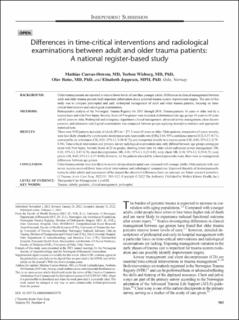| dc.identifier.citation | Cuevas-Østrem, M., Wisborg, T., Røise, O., & Jeppesen, E. (2022). Differences in time-critical interventions and radiological examinations between adult and older trauma patients: A national register-based study. Journal of Trauma and Acute Care Surgery, 93(4), 503-512. | en_US |
| dc.description.abstract | BACKGROUND
Older trauma patients are reported to receive lower levels of care than younger adults. Differences in clinical management between adult and older trauma patients hold important information about potential trauma system improvement targets. The aim of this study was to compare prehospital and early in-hospital management of adult and older trauma patients, focusing on time-critical interventions and radiological examinations.
METHODS
Retrospective analysis of the Norwegian Trauma Registry for 2015 through 2018. Trauma patients 16 years or older met by a trauma team and with New Injury Severity Score of 9 or greater were included, dichotomized into age groups 16 years to 64 years and 65 years or older. Prehospital and emergency department clinical management, advanced airway management, chest decompression, and admission radiological examinations was compared between groups applying descriptive statistics and appropriate statistical tests.
RESULTS
There were 9543 patients included, of which 28% (n = 2711) were 65 years or older. Older patients, irrespective of injury severity, were less likely attended by a prehospital doctor/paramedic team (odds ratio [OR], 0.64; 95% confidence interval [CI], 0.57–0.71), conveyed by air ambulance (OR, 0.65; 95% CI, 0.58–0.73), and transported directly to a trauma center (OR, 0.86; 95% CI, 0.79–0.94). Time-critical intervention and primary survey radiological examination rates only differed between age groups among patients with New Injury Severity Score of 25 or greater, showing lower rates for older adults (advanced airway management: OR, 0.60; 95% CI, 0.47–0.76; chest decompression: OR, 0.46; 95% CI, 0.25–0.85; x-ray chest: OR, 0.54; 95% CI, 0.39–0.75; x-ray pelvis: OR, 0.69; 95% CI, 0.57–0.84). However, for the patients attended by a doctor/paramedic team, there were no management differences between age groups.
CONCLUSION
Older trauma patients were less likely to receive advanced prehospital care compared with younger adults. Older patients with very severe injuries received fewer time-critical interventions and radiological examinations. Improved dispatch of doctor/paramedic teams to older adults and assessment of the impact the observed differences have on outcome are future research priorities. | en_US |

